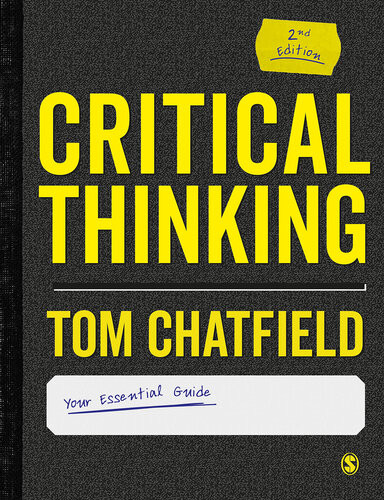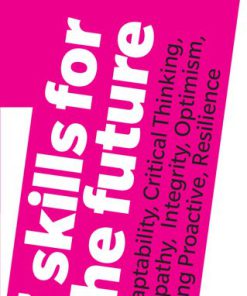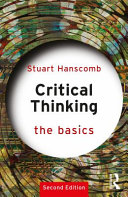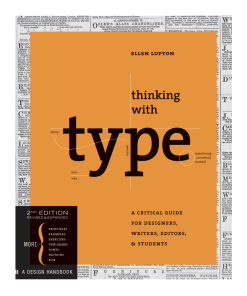Critical Thinking Your Guide to Effective Argument Successful Analysis and Independent Study 2nd Edition by Tom Chatfield 1529718538 9781529718539
$50.00 Original price was: $50.00.$25.00Current price is: $25.00.
Critical Thinking Your Guide to Effective Argument Successful Analysis and Independent Study 2nd Edition by Tom Chatfield – Ebook PDF Instant Download/Delivery: 1529718538, 9781529718539
Full download Critical Thinking Your Guide to Effective Argument Successful Analysis and Independent Study 2nd Edition after payment

Product details:
ISBN 10: 1529718538
ISBN 13: 9781529718539
Author: Tom Chatfield
What is critical thinking? How do you apply it in your assessments? How do you build a good argument or find evidence? Critical thinking is a set of techniques. You just need to learn them. This is your personal toolkit for demystifying critical thinking. Clear and focused, it shows you how to sharpen your ability to think critically by developing and honing your skills. You’ll learn how to: Build a solid argument and express your ideas clearly Evaluate evidence and identify errors Understand and account for biased or flawed thinking Become a savvy user of technology Sift through the deluge of digital information Develop confident critical writing. Designed to work with a power pack of digital resources and exercises, you′ll find practical and effective tools to think and write critically in an information-saturated age. Whether you′re starting your first degree or arriving as an international or mature student, this book equips you with the skills, insights and confidence to succeed. This second edition has been redesigned and fine-tuned with a focus on accessibility: with a new and improved layout to improve the eBook experience, and updated language, examples and further reading recommendations throughout.
Critical Thinking Your Guide to Effective Argument Successful Analysis and Independent Study 2nd Table of contents:
PART I THE ART AND SCIENCE OF BEING REASONABLE
1 Understanding the reasons behind things
What is an argument? Persuasion through reasoning
Spotting arguments by searching for a conclusion
What isn’t an argument? Information without reasoning
Explanations: the business of reasoning backwards
What isn’t an argument? Persuasion without reasoning
Summary
2 Spelling out arguments and assumptions
Premises and conclusions: the standard form
Reconstructing extended arguments
A step-by-step guide to reconstructing arguments
A few further words about assumptions
Putting it all together
Summary
3 Reasoning with logic and certainty
Introducing deductive reasoning
Valid and invalid arguments
Necessary and sufficient conditions
Two types of valid and invalid reasoning
Sound and unsound arguments
Summary
4 Reasoning with observation and uncertainty
Argument by induction
Introducing inductive force
Induction and everyday language
Addressing uncertainty through probability
Making use of samples
The problem of induction
Induction and falsification
Summary
5 Developing explanations and theories
Introducing abduction
Explanations, theories and hypotheses
Moving towards better explanations
Moving from evidence to proof
Correlation and causation
Conducting meaningful research
Summary
6 Assessing evidence and planning your reading strategy
Engaging critically with primary and secondary sources
Creating a strategy for critical reading
Note-taking and critical engagement
Summary
PART II BEING REASONABLE IN AN UNREASONABLE WORLD
7 Getting to grips with rhetoric
The power of language and rhetoric
Putting persuasion in context
Analysing a message in detail: emotion and human stories
Aiming for impartiality
Rhetorical devices
Summary
8 Seeing through faulty reasoning
Fallacious arguments and faulty reasoning
Formal and informal fallacies
Informal fallacies of relevance (red herrings)
Informal fallacies of ambiguity (linguistic fallacies)
Informal fallacies of presumption (material fallacies)
Two formal fallacies: affirming the consequent and denying the antecedent
The undistributed middle: a formal fallacy
Base rate neglect: another formal fallacy
From base rate neglect to Bayes’s theorem
Summary
9 Understanding cognitive bias
Four types of heuristic
When to trust heuristics and when to distrust them
Biases based on how things are presented
Biases born from over-simplification
Biases born from a lack of insight
Behavioural economics and the research context
Summary
10 Overcoming bias in yourself and others
Attaching excessive significance to random events
Failing to consider things that didn’t happen
Over-estimating regularity and predictability
Humans: good at social situations, bad with numbers
Summary
11 Thinking critically about technology
From data to knowledge via fake news
Social proof and system bias
Time, attention and other people
Search, discovery and categories of knowledge
Practical tips for search, discovery and beyond
Summary
12 Putting it all together: critical thinking in study, work and life
Good writing in general
Good academic writing in particular
Writing and rewriting in practice
Getting the work done: what is holding you back?
Critical thinking and you
Ten commandments for critical thinking
People also search for Critical Thinking Your Guide to Effective Argument Successful Analysis and Independent Study 2nd:
9 critical thinking traits 20
8 critical thinking skills 20
6 critical questions 50
6 critical thinking skills
Tags:
Tom Chatfield,Critical,Thinking,Effective
You may also like…
Business & Economics - Responsibility and Business Ethics
Science Fiction - Fantasy Fiction
History & Research
Politics & Philosophy - General & Miscellaneous Philosophy
Arts - Graphic Arts
Thinking with Type A Critical Guide for Designers Writers Editors Students 2nd Edition Ellen Lupton
Politics & Philosophy - Renaissance & Modern Philosophy
Smart thinking for critical understanding and writing 2nd Edition Matthew Allen
Education Studies & Teaching - Studying & Test Preparation











